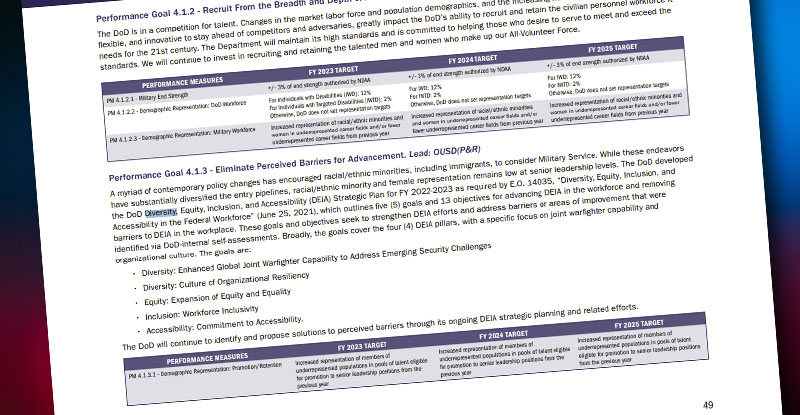Military officials told lawmakers the services do not entertain diversity quotas of any kind on Wednesday, but the Pentagon’s Diversity, Equity and Inclusion (DEI) strategy shows efforts to increase the number of allegedly underrepresented personnel.
The Department of Defense (DOD) has intensified efforts in previous years to promote a diverse and inclusive force, making DEI a cornerstone of force readiness, morale and recruiting programs.
However, officials testifying at a Senate Armed Services Committee hearing about the military’s ongoing recruitment issues denied setting specific targets for race and gender identity in response to questioning about whether the services’ DEI efforts have substituted federal prohibitions on job discrimination for “equity.”
“We do not have targets or anything associated with that as part of our DEI programs,” Army Under Secretary Gabe Camarillo told committee Ranking Member Sen. Roger Wicker of Mississippi.
Military officials said their services adhere to equal opportunity legislation requirements, and that equity-focused programs occur on a separate plane.
“What we are focused on is the process of building teams to perform the military mission,” Under Secretary of the Navy Erik Raven told senators. “This does not include quotas of any kind.”
However, officials and numerous strategy documents discuss goals of “increasing” the number of underrepresented minorities and ensuring the military has similar demographics to the general public.
DOD’s “Diversity, Equity, Inclusion and Accessibility Strategic Plan” for 2022 and 2023 does not outline specific percentage or numerical objectives for minority representation.
But, a strategy map detailing steps taken to achieve an “equity” goal sets forth two “objectives” related to expanding perceived equity and equality in the services.
One objective is “increased representation of underserved populations in underrepresented career fields and at all levels of the military and civilian force.”
The other requires using existing programs and authorities to “enhance DEIA inclusivity of the underserved communities surrounding DOD installations,” such as weapons manufacturers and other businesses that serve personnel on military bases.
A separate document laying out the Pentagon’s management strategy through 2026 presents an upward trend in the percentage of underrepresented military members increasing as a marker of DEI programs’ effectiveness.
Along with meeting DOD’s overall force size goals and meeting federally-required quotas for individuals with disabilities in the civilian workforce, the Pentagon hopes to see “increased representation of racial/ethnic minorities and women in underrepresented career fields,” like science and technology, in the coming three years, the document states.
“Our approach is to cast the widest possible net for talent anywhere it is,” Camarillo said at the hearing. The Army has increased outreach to areas of the country that recruiters previously de-prioritized “to make sure that the army is a place where everybody sees they have a role.”
The Air Force seeks to fulfill equity goals through building “diverse, powerful teams that are engaged and connected,” Kristyn Jones, acting under secretary of the Air Force, added. “In some areas we’re seeing where we have lower retention, lower promotion rates, higher nonjudicial punishment rates and we want to understand the root causes for that.”
Officials reiterated prior assertions that DEI programs have not negatively impacted recruitment or retention.
The Marine Corps and Navy are just as ready to address global threats as they have ever been, Raven said.








Leave a Comment